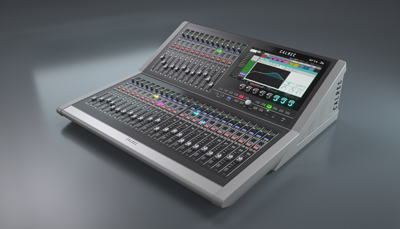Tech Focus: Audio Consoles, Part 1 — Adapting to an ‘At Home’ Future
No longer the center of signal processing, digital desks are taking their place on the network
Story Highlights
The sales process for audio consoles remains deeply rooted in pro audio’s past. Even when it comes to digital desks, selling them still seems more like selling Cadillacs than marketing extremely advanced processing equipment — which, when you think about it, both consoles and Cadillacs are these days. But the console is the emblem of the era when it was the hub of all audio-signal routing, even as it is increasingly a node — albeit a large one — on a network.
“The audio console needs to adapt, from an operational point of view, to be transparent, to be part of a larger networked system,” observes Henry Goodman, director of support and market development, Calrec. “It’s a changing landscape.”
Goodman and others refer both to the proliferation of networked audio as the primary audio-distribution modality and, more specifically, to ESPN’s pioneering use of its “remote-integration model” (REMI), in which a bare minimum of capture assets — cameras and microphones — are deployed onsite and the mixing and related tasks are performed at a central studio. So, while console manufacturers continue to produce large-format audio consoles for remote applications, they’re also adapting them and other platforms for a scaled-back process.
At NAB 2016, Calrec introduced two products that reflect this trend. The RP1 remote-production engine uses FPGA-based DSP to enable a console surface at one facility to remotely control all mixing functionality at another, managing all the processing for IFB routing and remote monitor mixes, and it does so locally with no latency. The company’s new Brio console is its smallest yet, its 36 dual-layer fader surface measuring about 35 in. wide.
Lawo is as dominant in outside-broadcast (OB) sports production in Europe as Calrec is in the U.S., and the German company has increased its U.S. footprint with four studio consoles installed in ESPN’s Bristol, CT, headquarters. But Don Bird, VP, business development, Lawo, is quick to point out that consoles are becoming nodes on a larger network and much of their processing is no longer confined to their form factors: “The work surface and the processing are no longer necessarily [one piece] anymore. The processing can be in a rack while the work surface can be a console or an iPad.”
More compact, more cost-effective and more network-ready have become mantras for remote-broadcast–console design in the last couple of years. DiGiCo’s year-old Orange Box lets that brand’s consoles interface not only with sister brand Calrec’s desks via the Hydra2 network but also to other networked nodes over other pathways, including Dante, BNC, Cat 5, Optocore, Aviom, ADC, and AES. Its sales motto “Anything In, Anything Out” reflects how the walls around proprietary formats that once locked users into branded product families are being breached by networking.
According to Chris Fichera, VP, audio, Group One, DiGiCo’s U.S. distributor, that puts more emphasis on smaller consoles, further opening up the market for small production trucks (Sprinters) as RSNs look to increase the sophistication of their broadcasts without breaking their budgets. He says his company’s $7,000 SD 21 and $23,000 SD 9 consoles target that market; he sees RSNs as nearing the ROI conclusion of their mostly analog audio infrastructure and attracted to networked digital’s lower costs and ease of integration.
“The small remote-production trucks used for the [Pac-12] and SEC conferences is where the growth is going to be,” he says. “The cost of these consoles is getting closer to what they can spend.”
Yamaha doesn’t have the market share in remote sports production that Calrec has, but it does have a history in compact consoles. Derived from its success in the touring-sound sector, its small yet powerful digital desks are showing up in small regional production trucks. The company was also an early licensee of the Dante networking format, so networked connectivity is deeply ingrained in its digital DNA. (Yamaha live-sound consoles are regularly found in FOH applications in stadiums as well.)
“Many smaller production companies have our consoles in them for their regional and local coverage,” notes Kevin Kimmel, mixer product manager, Yamaha. “Additionally, even the large production trucks often have a Yamaha DM1000 or other small-format Yamaha mixer as a sidecar/remote mixer in the truck.” The company lists NEP, All Mobile Video, Stokes Production Services, and Video One Productions among its users.
Kimmel acknowledges that, below the highest tier of remote broadcast production, it’s a wide-open market. That means having to keep as many points of connectivity integrated as possible; to that end, Yamaha consoles accommodate MADI as readily as Dante. But it’s also a market with less long-term allegiance to brands; even Calrec, with its new downsized Summa console, is aiming for this widening market.
Lawo’s Bird says networked audio will ultimately offer some kind of parity between large and small production trucks as the console itself eventually shrinks. He’s not looking for that very soon but, he adds, “the next generation [of A1 mixers] will be very tech-savvy. They’re not in the trucks yet. But, when they are, it will look different.”
CLICK HERE for Tech Focus: Audio Consoles, Part 2 — Products Round-Up

